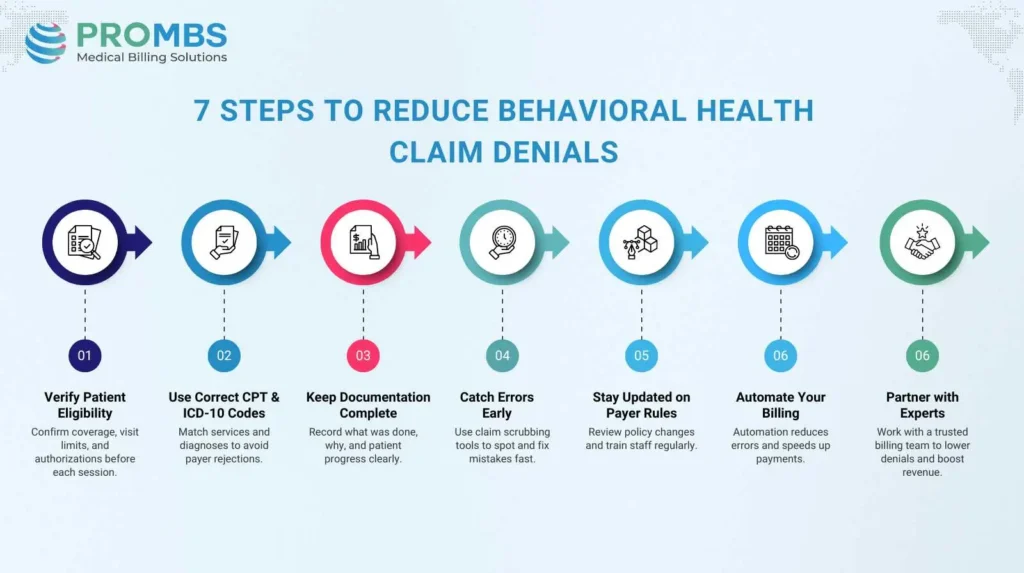Do you know how much high claim denial rates by insurance company can affect your behavioral health practice?
Every denied claim means delayed payments, added administrative work, and lost revenue. Over time, these denials can drain your cash flow and make it harder to focus on what matters most: your patients. Behavioral health billing is more complex than many other specialties. Each insurance company has its own rules, session limits, and documentation standards. Even a small mistake in a CPT or ICD-10 code, a missing authorization, or incomplete notes can trigger a denial. These small issues can quickly raise overall health insurance claim denial rates and increase frustration for your billing team.
The good news is that most denials can be avoided, and if they do happen, you can take the right steps to fix them. Understanding how to prevent rejections and how to appeal insurance claim denial cases helps you recover lost revenue faster. In this blog, we’ll share seven simple and effective tips to reduce rejected behavioral health claims and keep your billing process running smoothly.
Understanding Why Behavioral Health Claims Get Rejected
Behavioral health claim rejections often come from small mistakes that are easy to miss. Things like a wrong date of birth, missing documentation, or a simple coding error can stop a claim from being paid. These issues seem minor, but they can create real delays in getting reimbursed.
Do You Know?
According to the Centers for Medicare & Medicaid Services (CMS), nearly one in five medical claims submitted to payers are denied or delayed during initial processing. Behavioral health claims face even higher rejection rates, with studies showing denial rates reaching 20–30% due to missing information, invalid codes, or insufficient documentation. Strengthening verification and coding accuracy can help prevent most of these avoidable denials.
Common rejection causes include:
- Missing or invalid patient information.
- Incorrect CPT or ICD-10 codes.
- Lack of medical necessity notes.
- Payer-specific billing rule errors.
Have you ever lost time fixing a claim that could’ve been approved the first time? A quick review before submitting each claim can make all the difference. Taking just a few minutes to double-check details helps you avoid common mistakes, lower claim denial rates by insurance company, and get paid faster.
Step 1: Verify Patient Eligibility and Coverage Before Each Visit
Verifying patient coverage before each visit might feel routine, but it’s one of the easiest ways to avoid denials. Behavioral health plans often have unique rules, visit limits, or pre-authorization requirements. If you skip this step, even a clean claim can get rejected later.
When checking eligibility, confirm:
- Whether the policy is active and how many visits are covered
- If prior authorization or referrals are required
- What the copay, deductible, and network status are
Keeping these details documented helps you prove compliance and avoid payment delays.
Step 2: Use Correct CPT and ICD-10 Codes for Every Behavioral Health Service
Accurate coding is one of the simplest ways to reduce health insurance claim denial rates. CPT and ICD-10 codes must always match the documented service and diagnosis. If they don’t, the claim will likely be flagged or rejected.
According to the American Medical Association (AMA), coding errors are among the top three causes of claim denials in behavioral health services. Using the right codes not only prevents rejections but also supports medical necessity.
Here are some of the most common CPT codes for behavioral health:
- 90832–90838: Psychotherapy sessions
- 90791–90792: Psychiatric evaluations
- H0004–H0032: Substance use and counseling services
As per the Centers for Medicare & Medicaid Services (CMS), using detailed and specific diagnosis codes is crucial. For example, using “F32.1” for moderate depression gives payers a clearer reason for treatment than a broad code like “unspecified mood disorder.” CMS guidance also shows that non-specific codes are one of the top reasons for medical necessity denials in mental health billing.
The American Psychiatric Association (APA) also notes that coding accuracy directly impacts reimbursement timelines. When CPT and ICD-10 codes align correctly, claims move faster through payer systems, helping providers avoid unnecessary follow-ups and appeals.
Step 3: Keep Clinical Documentation Complete and Consistent
Good documentation is more than a billing task. It’s the foundation for accurate claims, compliance, and patient care. Every note should clearly explain what was done, why it was needed, and what results were achieved. If documentation doesn’t support the billed service, payers can deny the claim even if the coding is perfect.
Why Strong Documentation Matters
According to the Behavioral Health Business Journal (BHBJ), nearly 40 percent of behavioral health claim denials are linked to incomplete or inconsistent documentation. Payers use documentation to confirm that services were medically necessary. When treatment notes and billing codes do not match, it often leads to rejection or delay. The National Institute of Mental Health (NIMH) also highlights that detailed progress notes are essential for proving medical necessity. Clear records reduce denial insurance claim cases and improve continuity of care for patients.
What Should Be Included in Each Note
A complete behavioral health session note should include:
The service provided: Describe the exact service you delivered during the session. Include the type of therapy, duration, and specific techniques used. This helps the payer understand what care was given and ensures the service matches the CPT code billed.
The reason for treatment: Explain why the session or service was needed. Link it to the patient’s diagnosis or current treatment goals. Clear reasoning shows medical necessity, which is one of the main factors payers look for when reviewing claims.
The patient’s progress: Record how the patient responded to the session. Note any changes in behavior, mood, or symptoms, even small improvements. Showing progress or continued need for care supports your billing and demonstrates the value of ongoing treatment.
The next steps: Outline what comes next in the treatment plan. Include follow-up appointments, changes to therapy methods, or recommendations for continued support. This shows the payer that care is structured, ongoing, and clinically justified.
When these details are consistent, your claim tells a clear story that payers can easily verify.
Keep Records Consistent Across All Documents
Step 4: Catch and Correct Claim Errors Before Submission
Even a small typo or missing modifier can lead to a denial. That’s why catching errors before claims go out is so important. Automated claim scrubbing tools can scan each claim for missing data, incorrect codes, or mismatched information.
The Healthcare Financial Management Association (HFMA) reported that up to 60% of claim denials are preventable when providers use automated error-detection tools. These tools flag problems early, allowing staff to correct them before submission.
According to Rev-Cycle Intelligence, healthcare practices that implemented claim automation saw denial rates drop by more than 20%. That means more clean claims, fewer reworks, and faster payments. In short, a few minutes of review before submission can save hours of rework and lost revenue later.
Step 5: Stay Updated on Payer Policies and Billing Rules
Insurance policies change often, and missing an update can cause problems. A code that was valid last year might now require extra documentation or prior authorization. Staying informed helps your team submit cleaner, more accurate claims. As per Medical Group Management Association (MGMA) reports, about 15% of claim denials happen because billing staff are unaware of recent payer rule changes. Subscribing to payer newsletters and checking online portals for updates helps you stay compliant.
The American Hospital Association (AHA) also emphasizes the importance of regular staff training. When billing teams stay current with payer rules, they reduce errors and improve the overall success rate of claim approvals.
Here are a few practical steps to stay compliant:
- Subscribe to payer newsletters and CMS updates
- Review rule changes every quarter
- Train billing staff on new requirements regularly
Step 6: Automate Claims with a Trusted Behavioral Health Billing Software
Automation can save your team time and improve accuracy. Modern billing software verifies eligibility, checks code accuracy, and even resubmits denied claims automatically. This reduces the chance of human error and keeps your claim cycle moving smoothly.
According to the American Hospital Association (AHA), practices that use automated billing systems report up to 30% fewer denials compared to those using manual methods. The Healthcare Information and Management Systems Society (HIMSS) adds that automation improves cash flow by identifying and correcting common claim errors before they reach the payer.
Benefits of Automation
Automation offers more than convenience; it creates a faster, cleaner, and more reliable billing process. By using smart software to handle repetitive tasks, your team can focus on accuracy, prevent claim errors, and improve cash flow. The table below shows how automation helps at each stage of the billing cycle.
| Feature | Description | Impact |
|---|---|---|
| Eligibility checks | Confirms active coverage | Fewer denied claims |
| Code validation | Ensures correct CPT/ICD-10 match | Lower error rates |
| Auto resubmission | Quickly fixes and resends claims | Faster payments |
Step 7: Partner with Pro-MBS to Simplify Behavioral Health Billing
Even with the best internal processes, managing claim denials can still take valuable time away from patient care. Partnering with an experienced behavioral health billing company ensures your claims are handled accurately from start to finish.

According to the American Medical Billing Association (AMBA), outsourcing complex billing tasks can reduce overall claim denial rates by more than 25%. A trusted partner not only manages eligibility checks and coding accuracy but also monitors payer rule changes and appeals denied claims quickly.
Collaborating with experts gives your staff more time to focus on patients while improving your financial performance. Reducing behavioral health claim denials requires precision, consistency, and experience. Pro-MBS helps providers lower claim denial rates by insurance company, improve cash flow, and streamline billing operations.
By working with a specialized team, you gain access to:
- End-to-end claim management: From verification to reimbursement.
- Advanced billing software: To automate routine tasks and improve accuracy.
- Denial management expertise: Professionals who know how to appeal and resolve complex denials.



